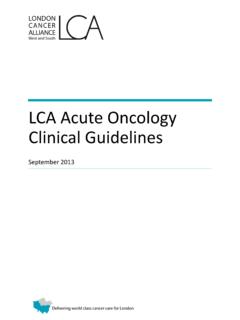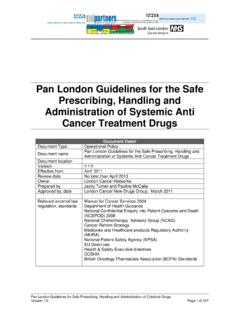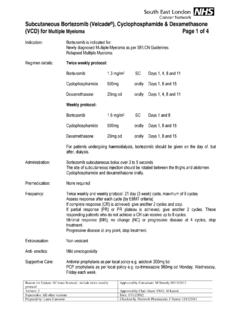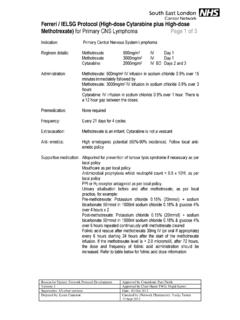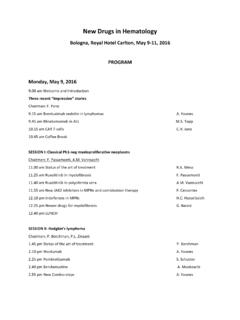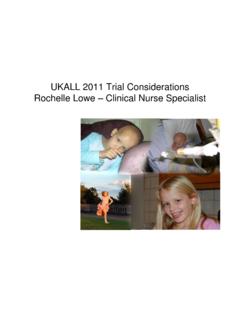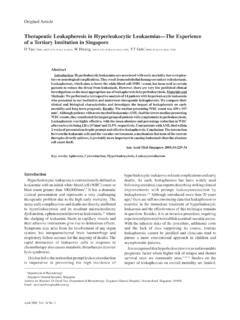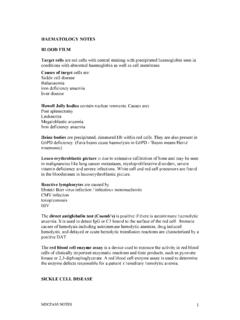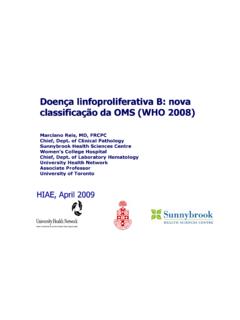Transcription of LCA Haemato-Oncology Clinical Guidelines
1 LCA Haemato-Oncology Clinical Guidelines acute leukaemias and Myeloid Neoplasms Part 1: acute lymphoblastic Leukaemia April 2015. LCA Haemato-Oncology Clinical Guidelines . Contents 1. Introduction .. 4. 2. Referral Pathways .. 5. Children, teenagers and young adults .. 6. 3. Investigation and Diagnosis .. 7. Fertility .. 7. Peripheral blood film .. 7. Bone marrow aspirate .. 8. Flow cytometry .. 8. Cytogenetics .. 8. Bone marrow trephine .. 8. Imaging .. 9. Pathology .. 9. Bone marrow aspiration and trephine (BMAT) .. 9. 4. Patient Information/Support .. 10. 5. Treatment .. 11. Initial management considerations .. 11. Initial cytoreduction with dexamethasone .. 11. Clinical trials .. 11. Specific therapeutic problems .. 12. Allogeneic stem cell 13. Management of elderly patients with ALL .. 14. Patients not wishing to enter a Clinical 14. 6. Management of Disease and Treatment-related Complications .. 17. Anaemia.
2 17. Neutropenic sepsis .. 17. Severe thrombocytopenia .. 17. Thrombosis/haemostasis .. 18. Haemostasis and thrombosis .. 18. Hyperleukocytosis/hyperviscosity syndrome .. 18. Leukapheresis .. 18. Hyperuricaemia and tumour lysis syndrome (TLS) .. 19. Central nervous system symptoms .. 19. L-asparaginase-related complications .. 19. 2. CONTENTS. Methotrexate encephalopathy .. 19. 7. Supportive Care .. 20. Transfusions .. 20. Hyperviscosity syndrome .. 20. Hyperuricaemia .. 20. Infection prophylaxis .. 20. Mouth care .. 21. Control of menstruation .. 21. Breathlessness .. 21. Weight loss .. 22. 22. Complex symptom management .. 22. 8. End-of-treatment Information .. 23. Treatment summary and care 23. 9. Follow-up Arrangements .. 24. 10. Rehabilitation and Survivorship .. 24. 11. Research/ Clinical Trials .. 25. 12. End-of-life Care .. 25. 13. Data Requirements .. 25. Annex 1: acute Leukaemia Patient Pathway .. 26.
3 Annex 2: acute Lymphoid Leukaemia Checklist .. 27. Annex 3: LCA acute leukaemias and Myeloid Neoplasms BMAT Diagnostics Summary 28. Annex 4: Multidisciplinary Teams (MDTs) and Constituent Hospital Trusts .. 29. Annex 5: Guideline for the Management of Tumour Lysis Syndrome (TLS) .. 30. Annex 6: Guidelines for Use of Rasburicase in Adult Haematology and oncology 32. Annex 7: Oral Chemotherapy Patient Education Checklist .. 34. Annex 8: Monitoring of Long-term Survivors of Chemotherapy .. 36. Annex 9: NLBSS High-risk Referral Form for Haemato-Oncology Patients .. 38. Annex 10: SIHMDS or Current Diagnostic Services and Contacts .. 39. Annex 11: Data 40. Appendices .. 42. 3. LCA Haemato-Oncology Clinical Guidelines . 1. Introduction acute lymphoblastic leukaemia (ALL) is an uncommon malignant disorder in adults. It represents approximately 15% of all leukaemias in adults. Patients diagnosed with ALL and treated with intensive protocols should be cared for in a British Committee for Standards in Haematology (BCSH) Level 3 haemato - oncology unit which participates in Clinical trials for patients with ALL.
4 Treatment for ALL is primarily based around Clinical trials, which are quite regimented and driven by well- defined protocols. This guideline does not recapitulate these Clinical trials, but sets out a general guide to treatment strategies for new and relapsed patients. The main considerations are: ALL is an eminently curable disease in young patients that becomes harder to treat as the patient ages. Fewer patients are cured as age advances and therapeutic complications become increasingly common. All patients should be treated with age-appropriate therapy. Since the disease is rare and treatment is complicated, there are many areas of controversy where best practice is not defined. Patients should be treated within a Clinical trial wherever possible. Experienced specific and supportive care is required. For example, a European Working Group on adult ALL recommends that patients should be treated in centres which see at least five new patients a year.
5 Adherence to the detail and timing of scheduled schemes of treatment is important. Minimising therapeutic delays has a positive impact on outcomes. Recognising complications of therapy quickly and being aware of which complications require treatment cessation and which do not are also vital. Allogeneic bone marrow transplant is currently a common element of patient management for patients aged 25 years and over. Hence, all patients and siblings aged 25 and older should be tissue- typed at diagnosis and an unrelated donor search carried out if there are no sibling donors. In practice, this means informing the appropriate transplant centre about all age-appropriate new diagnoses of ALL. Currently, those aged between 25 and 65 years old, and all patients who are Philadelphia-positive (Ph+), should be considered as possible transplant candidates at diagnosis. Appropriate specimens should always be taken before therapy is started.
6 Cytogenetic testing is the standard of care. Minimal residual disease (MRD) assessment is also now standard practice. This requires a diagnostic specimen to be sent centrally to the adult MRD laboratory at the Royal Free Hospital (RFH; for patients enrolled into UKALL14 or UKALL60+ Clinical trials), the paediatric MRD. laboratory at Great Ormond Street Hospital (GOSH; for UKALL2011 Clinical trial), or to the local Specialist Integrated Haematological Malignancy Diagnostic Service (SIHMDS) for those patients not on a study, in order to identify patient-specific markers at diagnosis. 4. REFERRAL PATHWAYS. 2. Referral Pathways See Annex 1: acute Leukaemia Patient Pathway. Patients with suspected ALL should be referred to a haematologist for assessment on the same day on a 2 week wait pathway (see Appendix 1: 2 Week Wait Referral Forms). Patients with severe neutropenia, thrombocytopenia or blasts in peripheral blood picked up on a routine blood test via the laboratory and suspected ALL should be urgently referred to an A&E department or directly to a Haemato-Oncology inpatient unit which treats ALL (BCSH Level 3).
7 All new patients should be referred to the multidisciplinary team (MDT) for confirmation of diagnosis, prognosis and management plan, taking into account their performance status, needs and co-morbidities (see Annex 4). Planning for an allogeneic stem cell transplant should begin at the time of diagnosis in conjunction with the transplant centre. A joint approach with elderly care physicians and palliative care teams may be appropriate in patients with poor prognosis disease and who are not eligible for transplant. MDT discussions should be had for: all new patients with ALL in order to confirm the diagnosis and treatment plan all patients where a new line of therapy needs to be considered all patients with a restaging assessment of response to treatment all patients for whom an allogeneic stem cell transplant is a consideration. Information to be captured and documented prior to or during the MDT should include: demographic information referring physician and/or GP.
8 Performance status an indicator of co-morbidities ( co-morbidity score). any relevant history pertinent positive and negative findings on physical examination (splenomegaly, rashes, etc). FBC, haematinics, LFTs, U&E, LDH, urate, SPEP, peripheral blasts bone marrow aspirate and trephine histology bone marrow aspirate immunophenotyping cytogenetic, Ph/MLL/IgH/TCR rearrangement status (critical for MRD assessment). specific diagnostic ALL sub-type by WHO 2008. relevant imaging ( CT staging). risk score availability of a Clinical trial/research study and if the patient is eligible management and treatment plan Clinical nurse specialist/key worker named consultant. 5. LCA Haemato-Oncology Clinical Guidelines . The MDT outcome form should be sent to the GP (by email, or preferably by fax) within 24 working hours of the MDT discussion. Patients with ALL should be discussed at an MDT meeting within two weeks of diagnosis it is expected that treatment would have commenced prior to the MDT discussion.
9 New patients should be discussed with the MDT ALL lead or the MDT lead at presentation for urgent agreement on the management plan prior to formal MDT discussion. Children, teenagers and young adults Children below the age of 16 years with a diagnosis of ALL or suspected ALL must be referred to the paediatric oncology team at the principal treatment centre (PTC) and must not be managed exclusively by adult site-specific teams. The joint PTC for children aged below 16 years for South Thames is The Royal Marsden (Sutton)/. St George's Hospital. The PTC for North Thames (including North West London) is Great Ormond Street Hospital/. University College London Hospitals. All patients <1 year from both North and South Thames should be referred to Great Ormond Street Hospital. Please see Appendix 2 for contact information for the children's PTCs. Teenagers aged 16 18 should be managed at a PTC for teenage and young adult (TYA) cancers.
10 Young adults aged 19 24 should be given the choice of being managed at a PTC or TYA designated hospital. The PTC for TYA for South Thames is The Royal Marsden (Sutton). The PTC for North Thames (including North West London) is University College London Hospitals. All patients within this age range, regardless of place of care, should be referred to the TYA MDT at the relevant PTC. Please see Appendix 3 for information about how to make a referral and contact information for the PTC and TYA designated centres in the LCA. 6. INVESTIGATION AND DIAGNOSIS. 3. Investigation and Diagnosis Patients may present with B-symptoms, bone pain, central nervous system (CNS) symptoms and/or cytopenias with or without lymphadenopathy/hepatosplenomegaly. When a diagnosis of ALL is suspected, appropriate tests should be undertaken (see Annex 2). An FBC should be performed in elderly patients presenting with symptoms of anaemia, infection or bruising/bleeding.


